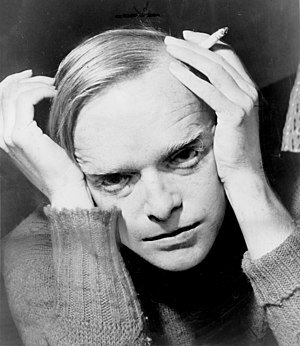© I.Woloshen
This is a more recent song lyric that was born from one line that hit me in the car (don’t worry, I wasn’t hurt 🙂 )on the way home from dropping the kids off at school.
I thought it might be an interesting thing to take you through the process I went through in creating this lyric. I have mentioned before that usually my songs come from a “music first” place, but in the last couple of years, I’ve noticed a tendency to come up with a line and melody at once.
I saw a man that I’ve seen many times, walking down the street. I don’t know him personally, but when I look at him, he reminds me of someone…
“There is a man who looks like Truman Capote“
That was the line…now I had no idea where the song was going to go, I had only that line! What on earth was this song going to be about? Some people start with a central idea or theme…these days, I tend to write the first line and then try to build a song from there.
So I recorded it into my trusty micro-cassette recorder, and left it for awhile. Later, I pulled it out, along with my guitar, and started playing around with it. The melody had come at the same time, so I picked a chord and a key and let the words kind of come out as I was creating the melody.
Okay. There is a man who looks like Truman Capote…I thought I’d give a bit of a description next:
There is a man who looks like Truman Capote
He wears a slanted smile and a wide-brimmed hat
A little pigeon-toed, a lot eccentric
He gets a kick out of what he’s smiling at
And as I pass him on the street I wonder
What it is he’d have to say…
But what’s the song about? At this point, I remembered something my Dad talked about once…how he always remembered the “characters” that were around when he was a kid: characters who had idiosynchracies or looked or spoke a little strangely whom he never forgot.
This made me think about another older woman who we buy pumpkins from every year…she has an old house and some property and it’s become our tradition to always buy our hallowe’en pumpkins from her:
There is a woman, must be in her nineties
She sells her pumpkins every Hallowe’en
She’s all bent over with the weight of something
But every year, her crop’s the best I’ve seen
And as she prices out the one I’ve chosen
I wonder what she’d have to say
Now it seemed was the right time for a chorus…as it turns out, I wrote a melody and a different chord progression, but no lyrics! I just hummed a melody. Now, that’s not very conventional…but somehow or other, it works. If it feels good, do it 🙂
So did I just want to write about characters? I could probably think of others, but at this point, I decided to take a different direction:
A friend of mine who rides the bus on weekdays
With sixty travelers she’ll never know
She looks at every one and writes their story
To entertain herself when the ride is slow
If she saw Truman and the Pumpkin Lady
She’d know just what they had to say….
All of these people are real people…there really is a friend who does this…I always thought it was an interesting way to pass the time on a bus! It just goes to show that little bits and pieces of ideas and thoughts can stay with you and come in handy in your songwriting sometimes. And it gave me the title of the song…again, not very conventional, because there’s no lyrical chorus, which is where the title is more commonly found. So I decided at this point to call the song “Truman and the Pumpkin Lady”. Kind of unusual :-). Now I needed to finish the song…how do I tie all of these thoughts together? This is what I came up with:
And as we reach our final earthly hours
Looking back at what our lives have been
It will appear as though a giant weaving
Of every person, place, and time we’ve seen
And maybe someone will pass by and wonder
What it is we’d have to say…
Then I finished with humming that chorus again…a kind of wistful exit to a wistful lyric. One point I’d like to make is that I wrote it all in the present tense…this is intentional. If I had written it in past tense, it would have had less impact. There is an immediacy to the present tense that works very well with this type of lyric.
Of course, the verses didn’t come out all that easily and just as I’ve shown them here…they went through two or three drafts first. And is the song finished? I dunno!! But that’s the story of how it got this far.
***Update*** I finally broke down and wrote lyrics to the chorus…in fact I changed the chorus melody altogether. Why? Because I felt it was missing a summation, outside of the repetition of the line at the end of each verse. Here it is:
Don’t be unkind
Live a simple life
Laugh at yourself sometimes
Look at me now
You’ll be here someday
So love a little bit along the way
When I was in my teens I bought my step-grandmother a little wall plaque, that said “Live, Laugh and Love”. She thought it represented exactly what she believed. So there you go.

![Reblog this post [with Zemanta]](http://img.zemanta.com/reblog_e.png?x-id=3fa545f4-c501-4370-9cf5-d39b187d8a03)

![Reblog this post [with Zemanta]](http://img.zemanta.com/reblog_e.png?x-id=6785e0af-4ac7-47c2-80e7-0bf12a3d2f66)
![Reblog this post [with Zemanta]](http://img.zemanta.com/reblog_e.png?x-id=937bb6c6-4f02-40cb-8c7f-794cd0928e81)
![Reblog this post [with Zemanta]](http://img.zemanta.com/reblog_e.png?x-id=cc3f3bdd-867b-4941-97d6-ac27b2acb972)

![Reblog this post [with Zemanta]](http://img.zemanta.com/reblog_e.png?x-id=086f0058-0d31-4f9f-a672-566dc3e535b2)